

Etre présent à l'instant de la mort... The Radical Plasticity Thesis: How the Brain Learns to be Conscious. Consider the humble but proverbial thermostat.
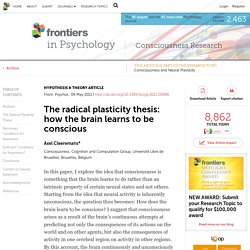
A thermostat is a simple device that can turn a furnace on or off depending on whether the current temperature exceeds a set threshold. Thus, the thermostat can appropriately be said to be sensitive to temperature. But is there some sense in which the thermostat can be characterized as being aware of temperature? Contra Chalmers (1996), I will argue that there is no sense in which the thermostat can be characterized as being aware of temperature.
Your brain does not process information and it is not a computer. No matter how hard they try, brain scientists and cognitive psychologists will never find a copy of Beethoven’s 5th Symphony in the brain – or copies of words, pictures, grammatical rules or any other kinds of environmental stimuli.

The human brain isn’t really empty, of course. But it does not contain most of the things people think it does – not even simple things such as ‘memories’. Our shoddy thinking about the brain has deep historical roots, but the invention of computers in the 1940s got us especially confused. For more than half a century now, psychologists, linguists, neuroscientists and other experts on human behaviour have been asserting that the human brain works like a computer. To see how vacuous this idea is, consider the brains of babies. Interaction Dynamics and Autonomy – Xabier E. Barandiaran. I am glad to post that Miguel Aguilera presented his PhD thesis and is now officially a doctor in cognitive science by the University of Zaragoza.
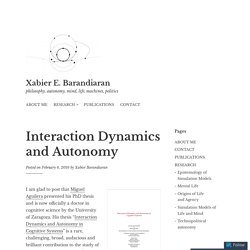
His thesis “Interaction Dynamics and Autonomy in Cognitive Systems” is a rare, challenging, broad, audacious and brilliant contribution to the study of autonomous systems. How does a “self” or an “autonomous system” emerge and constitute itself through interactions with the environment? It seems the answer is impossible to provide, you need to have a self, an identity, before it starts interacting with the environment, but, at the same time, some forms of sensorimotor or cognitive identity emerge and sustain themselves through interactions. Teaser "Turn off the light" Les statues meurent aussi. Les statues meurent aussi est un documentaire français réalisé par Chris Marker et Alain Resnais sorti en 1953.
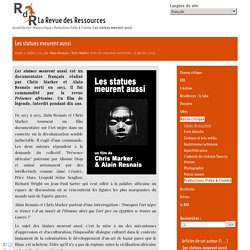
Il fut commandité par la revue Présence africaine. Un film de légende, interdit pendant dix ans. De 1952 à 1953, Alain Resnais et Chris Marker tournent un film documentaire sur l’Art nègre dans un contexte où la décolonisation semble inéluctable. Il s’agit d’une commande. Les deux auteurs répondent à la demande du collectif "Présence africaine" patronné par Alioune Diop et animé notamment par des intellectuels comme Aimé Césaire, Price Mars, Léopold Sédar Senghor, Richard Wright ou Jean-Paul Sartre qui veut offrir à la palabre africaine un espace de discussions où se rencontrent les figures les plus marquantes du monde noir de l’après-guerre.
Alain Resnais et Chris Marker partent d’une interrogation : "Pourquoi l’art nègre se trouve t-il au musée de l’Homme alors que l’art grec ou égyptien se trouve au Louvre ? " « On nous avait commandé un film sur l’art nègre. Chris Marker - Monoskop. Chris Marker (born Christian Hippolyte François Georges Bouche-Villeneuve) was a French writer, photographer, documentary film director, multimedia artist and film essayist.
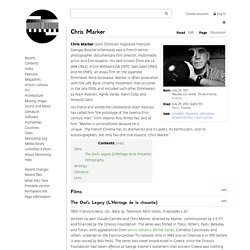
His best known films are La jetée (1962), A Grin Without a Cat (1977), Sans Soleil (1983) and AK (1985), an essay film on the Japanese filmmaker Akira Kurosawa. Marker is often associated with the Left Bank Cinema movement that occurred in the late 1950s and included such other filmmakers as Alain Resnais, Agnès Varda, Henri Colpi and Armand Gatti. His friend and sometime collaborator Alain Resnais has called him "the prototype of the twenty-first-century man. " G. Rouzier dit un cours de M. Jousse. Henri Van Lier Anthropogénie. Lessons From Swiss Style Graphic Design. Also known as International Style, the Swiss Style does not simply describe a style of graphic design made in Switzerland.

It became famous through the art of very talented Swiss graphic designers, but it emerged in Russia, Germany and Netherlands in the 1920’s. This style in art, architecture and culture became an ‘international’ style after 1950’s and it was produced by artists all around the globe. Arguments Rhétologiques Fallacieux — Information is Beautiful. Bijutsukai. 4 Million Year 2001: A Space Odyssey. 4 Million Year 2001: A Space Odyssey is a video and a net-art project, which consists of the famous ellipsis of Stanley Kubrick's film "2001: A Space Odyssey" (1968) slowed down so that a single, continuous viewing lasts for millions of years.
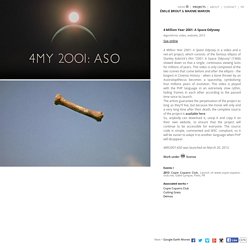
This video is only composed of the two scenes that come before and after the ellipsis - the longest in Cinema History - when a bone thrown by an Australopithecus becomes a spaceship, symbolizing four millions years of evolution. This video is played with the PHP language in an extremely slow rythm, fading frames in each other according to the passed time since its launch. The artists guarantee the perpetuation of the project as long as they'll live, but because the movie will only end a very long time after their death, the complete source of the project is available here.
So, anybody can download it, unzip it and copy it on their own website, to ensure that the project will continue to be accessible for everyone.